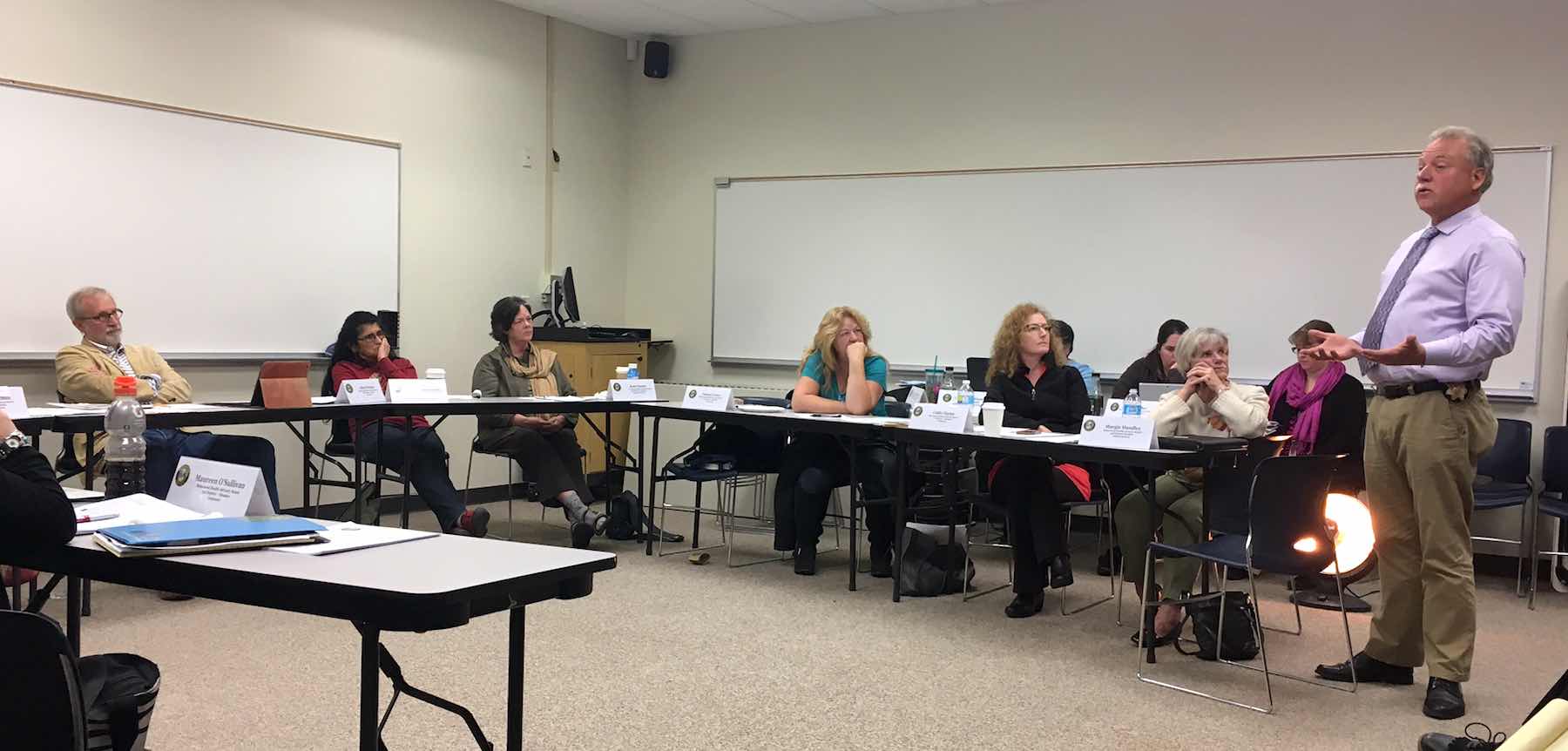WILLITS — The Behavioral Health Advisory Board (BHAB) passed a motion to formally support of Measure AG by a vote of nine to two at their October 19 monthly meeting in Willits. The measure, which requires a supermajority of two-thirds to pass, would raise sales tax county-wide, including in incorporated areas, by half a cent, and is projected to raise around $30 million over a five year period earmarked for the development of mental health facilities. The board’s vote occurred after presentations from the initiative’s primary proponent, Sheriff Tom Allman, Mendocino County Mental Health Director Dr. Jenine Miller, and a lively public discussion of the measure.

Sheriff Tom Allman talks about Measure AG with the Behavioral Health Advisory Board on October 19 in Willits.
A diverse range of opinions were expressed at the meeting about how to best improve the county’s services — some board members suggested expanding outpatient services and staffing would be a better use of funding, while others voiced full support of Measure AG. The BHAB serves in an advisory capacity to the Board of Supervisors and had no formal role in the development of Measure AG. This lack of input was mentioned by several members as detriment to AG. Board Chair John Wetzler was initially asked by Sheriff Allman to be on the committee which drafted the measure, but he subsequently ended his involvement. Former BHAB Chair Nancy Sutherland has spoken against the measure while acting as a private citizen.
If passed funds raised by the half-cent sales tax would go towards either building or “developing” mental health facilities within the county, but the language in the measure does not provide further details. A fiscal analysis conducted by the county’s Executive Office compared a few kinds of potential facilities, but several BHAB members questioned whether the funds could be used towards rehabilitating an existing structure, such as the former Frank R. Howard Memorial Hospital building.
Dr. Miller presented an overview of the county’s current mental health services, and detailed some of the licensing requirements, mandated staffing levels, and financial considerations of the different types of mental health facilities that could be funded by AG. One question raised by BHAB members was how the county would pay for and retain the minimum qualified staff required by different types of facilities. The difficulty of retaining such staff has been an ongoing issue for the county.
“There is no one here who doesn’t want the facilities the Sheriff proposes,” said Wetzler in opening the discussion, but he questioned whether the lack of funding for staffing would cause the county to cut back other services to cover those costs. Others echoed the concern over lack of staff funding in the measure and vagueness of the language, questioning whether county administrators and the supervisors could be trusted to make good decisions regarding services. One board member noted that a sales tax is regressive and impacts low-income residents more. Board member Maureen O’Sullivan suggested partnering with Mendocino College to develop training programs for psychiatric nurses and other needed staff.
Allman did not arrive until the middle of the board discussion. He began his discussion of the measure by explaining the county’s former Psychiatric Health Facility was closed due to problems with staffing, funding, and the emotional impacts of several suicides within a single year. “The supervisors don’t always make the best decisions,” he said of the closure of that unit.
Standing before the board, Allman spoke of the difficulties his deputies face in acting as the first line of response to residents in mental health crisis, noting new officers are trained to respond to threats and not those in crisis. He estimated about 20% of the current county inmates require mental health treatment, adding that some of the funds raised towards the measure will go towards officer mental health training. However, he said he did not think the measure would reduce costs at the jail as mental health staff would still be required there.
Addressing staffing budgets, Allman said the county is “paying other counties to staff their hospitals” by sending our patients to out-of-county facilities, and that taking in patients from other counties would balance the budget of the Mendocino’s new facilities. He added that if all the funds didn’t go towards a new facility, the remainder could be put towards facilities maintenance costs, and that interest on the funds raised would also go towards the facilities.
Allman told the board that Humboldt County also faced staffing issues, while Sonoma County was able to attract Mendocino County medical professionals to commute there. He said he told CEO Carmel Angelo that the county would have to recruit professionals if the measure passes, and the supervisors would ultimately decide whether to staff contractors or county employees.
Board member Margie Handley, who is also President of the Board of the Frank R. Howard Foundation, said the building could be available for free. “We’d give it to someone right now if they’d run it, we don’t want it to be vacant, it’s becoming a homeless center,” she said. Allman noted the building requires seismic upgrades to be licensed. Some board members spoke in support of facilities located in places other than Ukiah, while others discouraged the focus on hospitalization as the best solution to improving services.
One board member questioned why Allman was disparaging the supervisors’ decisions and yet pointing to them as the decision-making body regarding the AG funds. In response to that question — as well as to whether the proposed facility would be a locked one — Allman noted that the measure would create an 11 person committee, like the BHAB, that would hold meetings and advise the supervisors on funding decisions. He said he disagreed with the funding analysis conducted by the CEO’s office, adding, “I’m numb to getting upset at the CEO’s office.”
After Allman finished taking questions from the board and public, Margie Handley called for a board vote, and the motion carried by a vote of nine to two. The BHAB will be writing a letter to the supervisors to formally submit their support.



